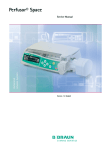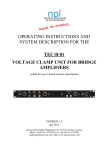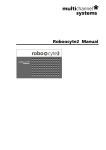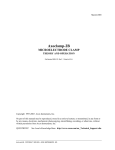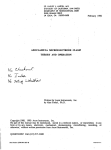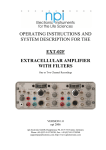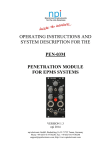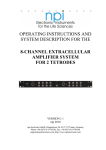Download OPERATING INSTRUCTIONS AND SYSTEM DESCRIPTION FOR
Transcript
OPERATING INSTRUCTIONS AND SYSTEM DESCRIPTION FOR THE RS-01R INSTRUMENT FOR MEASURING SERIES RESISTANCE IN TEVC RECORDINGS VERSION 1.1 npi 2006 npi electronic GmbH, Hauptstrasse 96, D-71732 Tamm, Germany Phone +49 (0)7141-9730230; Fax: +49 (0)7141-9730240 e-mail: [email protected]; http://www.npielectronic.com RS-01R User Manual _________________________________________________________________________________________________________________ Table of Contents 1. Safety Regulations .............................................................................................................. 3 2. Introduction......................................................................................................................... 4 2.1. Basic idea of RS measurement..................................................................................... 4 2.2. Solution........................................................................................................................ 4 2.3. Cell Model ................................................................................................................... 4 3. Description of the Front Panel ............................................................................................ 5 4. Connections ........................................................................................................................ 7 5. Operation ............................................................................................................................ 7 6. Adjustment Procedure Using a Cell Model - Example....................................................... 8 7. Links for Additional Information ....................................................................................... 12 8. Appendix............................................................................................................................. 12 ___________________________________________________________________________ version 1.1 page 2 RS-01R User Manual _________________________________________________________________________________________________________________ 1. Safety Regulations VERY IMPORTANT: Instruments and components supplied by npi electronic are NOT intended for clinical use or medical purposes (e.g. for diagnosis or treatment of humans), or for any other life-supporting system. npi electronic disclaims any warranties for such purpose. Equipment supplied by npi electronic must be operated only by selected, trained and adequately instructed personnel. For details please consult the GENERAL TERMS OF DELIVERY AND CONDITIONS OF BUSINESS of npi electronic, D-71732 Tamm, Germany. 1) GENERAL: This system is designed for use in scientific laboratories and must be operated by trained staff only. General safety regulations for operating electrical devices are to be followed. 2) STATIC ELECTRICITY: Electronic equipment is sensitive to static discharges. Some devices such as sensor inputs are equipped with very sensitive FET amplifiers, which can be damaged with electrostatic charge and must therefore be handled with care. Electrostatic discharge can be avoided by touching a grounded metal surface when changing or adjusting sensors. Always turn power off when adding or removing modules, connecting or disconnecting sensors, headstages or other components from the instrument or 19” cabinet. 3) TEMPERATURE DRIFT / WARM-UP TIME: All analog electronic systems are sensitive to temperature changes. Therefore, all electronic instruments containing analog circuits should be used only in a warmed-up condition (i.e. after internal temperature has reached steady-state values). In most cases a warm-up period of 20-30 minutes is sufficient. 4) HANDLING: Please protect the device from moisture, heat, radiation and corrosive chemicals. ___________________________________________________________________________ version 1.1 page 3 RS-01R User Manual _________________________________________________________________________________________________________________ 2. Introduction 2.1. Basic idea of RS measurement The instrument is based on the injection of symmetrical current pulses of 10 µA and a few kHz around the holding or resting potential of the cell. The membrane potential deviation that appears on the positive slope of the pulse is proportional to RS and is measured using high precision sample-and-hold circuits controlled by a timing unit that is synchronized from the injection pulses applied. RS is displayed on a digital meter with a resolution of 10Ω and can be also stored on a computer. RS measurement can be started manually or through a TTL input. After the measurement the stored RS value is displayed continuously until the next measurement is started. Therefore, measurement can be automated easily using standard lab software. 2.2. Solution The instrument is based on the injection of symmetrical current pulses of 10 microamperes and a few kHz around the holding or resting potential of the cell. The membrane potential deviation that appears on the positive slope of the pulse is proportional to RS and is measured using high precision sample-and-hold circuits controlled by a timing unit that is synchronized from the injection pulses applied. The RS measurement can be started manually or through a TTL input. After the measurement, the stored RS value is displayed continuously until the next measurement is started. To avoid jumps in the membrane potential, a holding current can be set manually or the current supplied by the TEC system is applied automatically from a sample-and-hold circuit. The RS measurement system can be used for automated procedures using standard lab software. One problem is the shape of the injected current (stimulus signal). It should be as square as possible, but in practice there are always parasitic capacitances leading to distortion of the current. Thus, the stimulus signal is conditioned in order to get an optimal square shape. We use a PD (proportional-differential) controller. Time constant and damping of the controller are adjustable to a certain extend. Depending on the frequency a constant measurement window for two sample-and-hold amplifiers is created and the time course of PEL is saved. The first measuring point represents the baseline and the second the value of PEL just before the increase caused by the capacitance of the cell or model cell respectively. The difference of the values of these two measurements corresponds to the value of RS. 2.3. Cell Model The properties of the RS measurement are tested best using a cell model that mimics not only electrode resistance, membrane resistance and membrane capacitance but also the series resistance (see also. A cell model with series resistance is available on request. ___________________________________________________________________________ version 1.1 page 4 RS-01R User Manual _________________________________________________________________________________________________________________ 3. Description of the Front Panel Figure 1: RS-01 R front panel view (the numbers are related to those in the text below) ___________________________________________________________________________ version 1.1 page 5 RS-01R User Manual _________________________________________________________________________________________________________________ In the following description of the front panel elements each element has a number that is related to that in Figure 1. The number is followed by the name (in uppercase letters) written on the front panel and the type of the element (in lowercase letters). Then, a short description of the element is given. Each control element has a label and frequently a calibration (e.g. PEL x10 mV). (1) POTENTIAL INPUT PEL x10 mV connector BNC connector for connecting the potential output (potential electrode) of the TEC amplifier. (2) CURRENT RANGE switch (optional) 4-position switch for selecting the CURRENT RANGE. If the TEC amplifier is equipped with a headstage with different current ranges, the CURRENT RANGE selected at the RS-01R must be the same as the CURRENT RANGE selected at the headstage. (3) DIFFERENTIATOR DAMP potentiometer Potentiometer for adjusting the damp factor of the PD controller. (4) FREQUENCY potentiometer Potentiometer for setting the frequency of the test pulses, range: ~2 kHz…5 kHz. (5) RS MEAS. switch Switch to select the RS measurement. CONT.: RS is measured continuously HOLD: The last measurement of RS is kept MAN.: RS is measured until the switch is released. (6) SERIES RESISTANCE (kΩ) display LED showing the measured RS in kΩ. (7) BIAS trim pot Trim pot to cancel the BIAS current. (8) HOLD. CURR. potentiometer Potentiometer for setting the HOLDING CURRENT manually, if #8 is in + or - position. (9) MODE OF OPERATION switch 4-position switch for selecting the MODE OF OPERATION (see also #8). +: positive HOLDING CURRENT is applied -: OFF: AUTO: negative HOLDING CURRENT is applied HOLDING CURRENT is disabled the RS-01R applies a HOLDING CURRENT as set at the TEC amplifier. (10) CURRENT HEADSTAGE CONNECTOR TEC 15-pole connector for connecting the TEC amplifier (see also chapter 4). ___________________________________________________________________________ version 1.1 page 6 RS-01R User Manual _________________________________________________________________________________________________________________ (11) CURRENT HEADSTAGE 15-pole connector for connecting the current headstage (see also chapter 4). (12) RS IN (TTL) BNC connector to connect a TTL signal for remote operation (HI: RS measurement on, LOW: RS measurement off. (13) RS OUT BNC connector providing a voltage proportional to the series resistance, scaling: 1V / kΩ. (14) TIME BASE potentiometer Potentiometer for setting the TIME BASE of the PD controller (15) POTENTIAL OUTPUT CEL x10 mV connector BNC connector providing the potential at the current electrode. Caution: The voltage at CEL can be up to 150 V!! (16) POTENTIAL OUTPUT PEL x10 mV connector BNC connector providing the potential at the voltage electrode. 4. Connections The RS-01R comes in a 19” rack mount cabinet and can be connected to every npi TURBO TEC amplifier using the supplied cable. Modification of the amplifier is not required. The current headstage is connected to the RS-01R with the 15-pole connector cable to CURRENT HEADSTAGE connector (#11, Figure 1). The 15-pole connector of the RS box (#10, Figure 1)is connected to the CURRENT HEADSTAGE connector at the TEC amplifier. PEL x10 (#1, Figure 1) is connected to PEL x10 at the front panel of TEC and to an oscilloscope. CEL at the front panel of the RS box is connected to the other channel of the oscilloscope. A power supply is not required. Caution: The voltage at CEL can be up to 150 V!! 5. Operation RS measurement is done in CC mode of the amplifier. If currently operating in VC mode and the MODE OF OPERATION switch at the RS-01R is set to AUTO, the TEC amplifier is automatically set to CC mode and the same holding current needed for setting the holding potential in VC mode, is applied to the cell. Thus, there should be only slightly changes in membrane potential, when switching to RS measurement in AUTO position. As a start point use a test pulse frequency of ~3 kHz (recommendation of Prof. Conti). Later, the frequency can be adjusted if necessary. Set the RS MEAS. mode switch (#5, Figure 1) to CONT. (continuous) or MAN. (manual). Then, make sure that the CURRENT RANGE switch is in the right position (see #2, Figure 1). You will see a value at the display of the RS box and the course of PEL and CEL at the oscilloscope. With the potentiometers DAMP. (#3, Figure 1)and TIME BASE (#14, Figure 1) adjust the shape of the CEL signal until it is as square as possible. Details of the procedure are ___________________________________________________________________________ version 1.1 page 7 RS-01R User Manual _________________________________________________________________________________________________________________ shown in the following figures. After adjustment, the value at the display of the RS-01R corresponds to the series resistance in X.XX kΩ. Notice: Because of the measuring method and the background noise you always will see values of at least 10 to 20 Ω, even if no series resistance is present (e.g. when using a cell model). The BNC connector RS (#13, Figure 1) OUT provides a DC voltage proportional to the value of series resistance (scaling: 1V / kΩ). As mentioned above, the measurement can be started using a TTL signal fed into the BNC connector RS IN (TTL) (#12, Figure 1) at the front panel of the RS box (HI starts the measurement). In principle, after the measurement (when the signal at TTL is low again or the switch is in the OFF position) the stored RS value is displayed continuously until the next measurement is started. 6. Adjustment Procedure Using a Cell Model - Example Important: You can test the RS-01R only with a cell model that mimics the series resistance!! Upper lane: signal of the potential electrode (200 mV / DIV) Lower lane: signal of the current electrode (2 V / DIV) Time base (for Figure 2): 5 ms / DIV 1 2 ) ) Figure 2: signals without RS box ___________________________________________________________________________ version 1.1 page 8 RS-01R User Manual _________________________________________________________________________________________________________________ Time base for Figure 3 to Figure 9): 100 µs / DIV s u lt0 o V :2 1 h C ) s u lt1 o V m :0 h C ) 2 Figure 3: Current electrode greatly under compensated (too low setting of TIME CONSTANT) s u lt0 o V :2 h C ) 1 lto V :m h C ) 2 s u 0 1 Figure 4: Current electrode slightly under compensated (still too low setting of TIME CONSTANT) ___________________________________________________________________________ version 1.1 page 9 RS-01R User Manual _________________________________________________________________________________________________________________ V :2 h C o 0 1 s u l) t :l) 2 h C o V m 0 1 s u t Figure 5: Current electrode over compensated (too high setting of TIME CONSTANT) 1 2 ) ) Figure 6: Current electrode correctly compensated (perfect setting of TIME CONSTANT) ___________________________________________________________________________ version 1.1 page 10 RS-01R User Manual _________________________________________________________________________________________________________________ s u lt0 o V :2 1 h C ) s u lt1 o V m :0 h C ) 2 Figure 7: Current electrode correctly compensated, but the delay is too high, i.e. the setting of DAMP is too low s u 5 t l o V 2 : 1 h C ) s u 5 t l o V m 0 : h C ) 2 Figure 8: Current electrode correctly compensated, but the delay is too low, i.e. the setting of DAMP is too high ___________________________________________________________________________ version 1.1 page 11 RS-01R User Manual _________________________________________________________________________________________________________________ s u lt5 o V :2 1 h C ) s u lt5 o V m :0 h C ) 2 Figure 9: Current electrode correctly compensated, the delay is good, i.e. the setting of DAMP is perfect 7. Links for Additional Information http://www.npielectronic.com/content/downloads/RS_spaceclamp.zip http://www.npielectronic.com/content/downloads/RS_Poster.zip http://www.npielectronic.com/content/downloads/RS_and_C_measurement.pdf 8. Appendix Series resistance measurement Poster presented at the 29th GÖTTINGEN NEUROBIOLOGY CONFERENCE 2003 (see http://www.npielectronic.com/content/downloads/RS_Poster.zip) ___________________________________________________________________________ version 1.1 page 12












